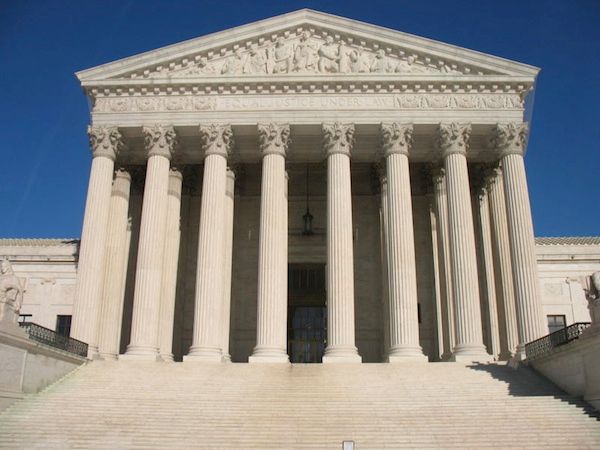Marriage Equality Case Could be Heard in Supreme Court


On Nov. 20, the justices of the US Supreme Court will decide whether they should hear one of the several cases that challenge the constitutionality of the Defense of Marriage Act, or DOMA. DOMA defines marriage as between a man and a woman for federal purposes, effectively preventing same-sex couples from receiving the benefits of several federal laws.
The case in question is Golinski v Office of Personnel Management. Karen Golinski, a lawyer for the Ninth Circuit Court of Appeals, married Amy Cunninghis during the brief period in 2008 when same-sex marriages were legal in California. Ms. Golinski has been unable to secure federal health benefits for her wife because the US Office of Personnel Management (OPM) prevented her insurance company from processing the application. By preventing this, OPM is enforcing DOMA, a law that effectively says that same-sex marriages will not be recognized by the federal government.
Originally, the Department of Justice represented OPM, but when President Obama and Attorney General Eric Holder announced they considered DOMA to be unconstitutional, the case was instead taken up by the Bipartisan Legal Advisory Group of the House of Representatives. This unusual turn in events pits the executive branch—which is refusing to enforce a law it considers unconstitutional—against the legislative branch—which enacted the law. The third branch, the judiciary, will need to step in to decide whether DOMA violates the Fifth Amendment.
Background on DOMA
DOMA was enacted in 1996 in response to a case before the Hawaiian Supreme Court that held that the state must show a compelling interest when prohibiting same-sex marriage. The case prompted concern that same-sex marriage might become legal in Hawaii and those marriages would have to be recognized in all states. The law passed with large majorities in both houses of Congress.
Not all of DOMA is controversial. Section 2 of DOMA, for example, expressly reaffirms that states can choose to accept or reject same-sex marriage. This means that a same-sex couple can marry in California, and can get the benefits of state laws. The controversy arises in Section 3 of DOMA, which defines “marriage” as the lawful union of one man and one woman, and defines “spouse” as a husband or wife of the opposite sex.
Thus far, eight federal courts have declared Section 3 of DOMA unconstitutional. Two of those courts are circuit courts, which are courts right below the Supreme Court in terms of hierarchy. But because our court system operates hierarchically, the Supreme Court does not need to agree with these lower courts. Ultimately, the Supreme Court only needs to follow the Constitution and its own former decisions, known as precedent.
Golinski v OPM
How the Court decides relevant precedent and its level of scrutiny on the law will determine whether our federal government can discriminate on the basis of sexual orientation, and that in turn will have far-reaching effects on the national understanding of marriage equality.
The Supreme Court does not review each case that has requested its attention. Under certain circumstances, though, the Court is exercising mandatory appellate review, which means that its decision to ignore the case is effectively a nod of agreement to the court below.
With regards to same-sex marriage, Baker v. Nelson was such a case in 1971. In Baker, two men applied for a marriage license in Minnesota, a state that does not recognize gay marriage. The Minnesota Supreme Court declared that Minnesota law limited marriage to opposite-sex couples, and that this limitation did not violate the Constitution. The Supreme Court dismissed the appeal, and because it was exercising mandatory appellate review, the Court’s decision to dismiss wasn’t just an act of ignoring a case it did not want to look at. It was effectively agreeing with the Minnesota Supreme Court.
While it is accepted that Baker is binding precedent on lower courts, it is unclear whether Baker controls the outcome for Golinski v. OPM. First, Baker’s facts must be very similar to the facts in Golinski in order for it to control. The tricky question is whether they are fundamentally different because Baker involved a challenge to a state law, and Golinski involves a challenge to a federal law.
Generally, marriage and family law is left to the states, believed to be better tools for recognizing the local quality of private life. Golinski will argue that Baker stood for the idea that the state’s marriage definition controls—Minnesota decided not to recognize gay marriage, and the federal government could not change that decision. By the same token, California decided to recognize gay marriage, and the federal government can’t refuse recognition of that marriage by withholding federal spousal benefits.
The Supreme Court could overturn Baker in Golinski or simply distinguish it on the grounds that federalism concerns require states, not Congress, to define marriage.
Politics and Golinski v OPM
In the realm of law, political platitudes familiar to the gay marriage debate become moot. It is not new for the Supreme Court to intervene when democracy results in the majority voting at the expense of a politically weak minority. This judicial behavior is most perfectly demonstrated in the Civil Rights Movement, and in cases like Brown v. Board of Education.The question the Court is faced with now is whether separation on the basis of sexual orientation can be equal, and if not, questions if sexual orientation is somehow different from race in a way that makes it not quite as deserving of the Constitution’s protections.
This case is not about preserving traditional marriage, because tradition alone cannot provide a rational basis for law. This case is about the proper balance of power between state and federal governments, and the scope of the equal protection guarantee. Because these questions cannot be answered by precedent alone, the Court’s decision will inevitably reshape the landscape of antidiscrimination law.



